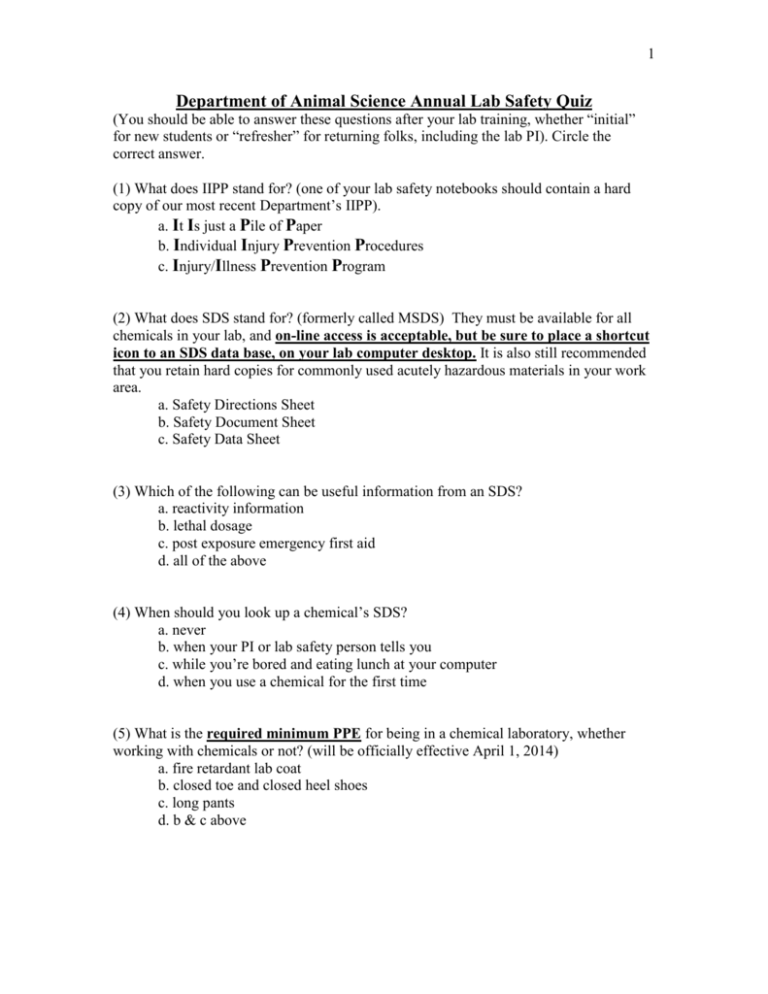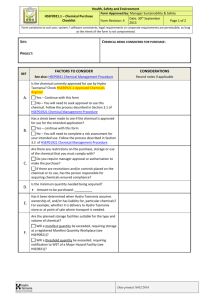Post Training Lab Safety Quiz 2015
advertisement

1
Department of Animal Science Annual Lab Safety Quiz
(You should be able to answer these questions after your lab training, whether “initial”
for new students or “refresher” for returning folks, including the lab PI). Circle the
correct answer.
(1) What does IIPP stand for? (one of your lab safety notebooks should contain a hard
copy of our most recent Department’s IIPP).
a. It Is just a Pile of Paper
b. Individual Injury Prevention Procedures
c. Injury/Illness Prevention Program
(2) What does SDS stand for? (formerly called MSDS) They must be available for all
chemicals in your lab, and on-line access is acceptable, but be sure to place a shortcut
icon to an SDS data base, on your lab computer desktop. It is also still recommended
that you retain hard copies for commonly used acutely hazardous materials in your work
area.
a. Safety Directions Sheet
b. Safety Document Sheet
c. Safety Data Sheet
(3) Which of the following can be useful information from an SDS?
a. reactivity information
b. lethal dosage
c. post exposure emergency first aid
d. all of the above
(4) When should you look up a chemical’s SDS?
a. never
b. when your PI or lab safety person tells you
c. while you’re bored and eating lunch at your computer
d. when you use a chemical for the first time
(5) What is the required minimum PPE for being in a chemical laboratory, whether
working with chemicals or not? (will be officially effective April 1, 2014)
a. fire retardant lab coat
b. closed toe and closed heel shoes
c. long pants
d. b & c above
2
(6) Which of the following is considered appropriate laboratory attire when working with
chemicals?
a. lab coat
b. safety glasses
c. nitrile gloves
d. a & b & c above
e. it depends on the activity and chemical (may need splash goggles or face shield
or different gloves).
(7) Before using gloves for protection, one should check for:
a. proper fit
b. compatibility with the chemical that is to be used
c. cracks or holes
d. all of the above
(8) Select which of the following are common ways for hazardous chemicals to enter the
body.
a. injection
b. ingestion
c. inhalation
d. absorption (e.g. through skin or eyes)
e. all of the above
(9) When a chemical spill occurs which covers a small amount of skin you should:
a. quickly soak up the material with paper towels or kimwipes
b. use the safety shower for 1 minute
c. flush with water for 15 minutes and notify your PI, and seek medical attention
if there is any question regarding its seriousness, and complete the department
injury forms and document how to prevent the incident from happening again
(10) Eye wash stations, safety showers, fire extinguishers and fire alarms are:
a. important safety devices required by law
b. located in chemical storage areas only
c. safety devices that you should be aware of (their location and how to use
them)
d. a and c, above.
3
(11) When and how often does anyone working in a lab need lab-specific safety training
that is documented ? (remember the PI needs documented training regardless of working
in the lab or not, because they must be aware of all the issues their employees or students
are exposed to).
a. Sometime during their first quarter at UCD and every 2 years
b. Sometime during your first week at UCD and every 2 years
c. Before working in a lab and annually.
(12) In terms of training…in addition to the above #11) there is an on-line lab safety
course now required by all folks before working in a chemical laboratory setting. What is
it called and how often is it required?
a. Lab Safety Training, every year
b. Chemical Laboratory Training, every two years
c. UC Laboratory Safety Fundamentals, every 3 years…and MUST be completed
by October 31, 2013.
(13) What do you do if you drop and break a full one gallon bottle of nitric acid on the
floor of your lab?
a. Get your spill kit and clean it up while holding your breath.
b. Run into the hall and pull the fire alarm.
c. Evacuate everyone from your lab and make sure all doors are closed and call
911.
(14) The following are all safety issues in the lab but what are the main issues CUPA
inspectors will check, when inspecting your lab?
a. Are folks wearing open-toed shoes AND eating in the lab.
b. Are there propped open fire doors AND blocked exits.
c. Is there lab specific safety training documentation for everyone in the lab
(including the PI) that is not over one year old AND are there properly labeled
waste labels on all chemical waste containers.
(15) During a fire alarm or other evacuation where is the Animal Science evacuation
site/meeting place? (make sure no one is still in the lab and close all doors behind you)
a. The nearest Starbucks.
b. Loitering in the breezeway area.
c. The NW area of the asphalt bike path, located just north of the Meyer Hall
loading dock entrance driveway.
4
(16) You have several empty glass one gallon containers of acids and solvents…how do
you properly dispose of them?
a. Triple rinse them and then go toss them into the dumpster.
b. If the container is empty, you can recycle with R4 (deface label and keep
capped to control odors). Do not rinse them as the rinse is considered waste.
c. Or place in solid waste (dumpster). Defacing the label or not, and keeping it
capped or not… is up to you, neither of these practices violates any regulation.
d. (b) and (c), above
(17) What are the guidelines for rinsing chemicals down the laboratory sink drain?
a. Any chemical can go down the drain in quantities less than a pound or gallon.
b. Whatever will not react violently when mixed with water.
c. Pretty much nothing, except some weak saline solutions, culture media mixed
with 10% bleach (final volume is 10% bleach), ethanol (EtOH) <24%, and a few
other similar items. Check with Safety Services or your safety coordinator if you
are not absolutely sure and read Safety Net #6
(18) {If you do not work with animal blood you may skip this question if you like}
You have collected some blood from some healthy animals (not treated with chemicals,
radioisotopes or biohazards), centrifuged down the RBC’s, collected the plasma or serum,
and now what do you do with the vacutainers of RBC’s?
a. Just toss them in the lab trash buckets.
b. Hide them in black plastic bags and throw them in the dumpster.
c. Treat them as hazardous waste and contact EH&S for pick-up.
d. Treat the RBC’s with bleach for 30 min (10% bleach final volume) and then
flush the mixture down the lab sink. The rinsed clean glass vacutainers can be
disposed of in the dumpster after autoclaving (see Safety Net #3).
(19) ALL bottles, flasks, and beakers of media, dry chemicals, buffers, saline, 1N or 1M
acids, or any other liquid (including distilled water) must be clearly labeled with which of
the following? (this includes items within your own lab and within common space…i.e.
walk in cold rooms).
a. A secret code so no one else can use your “stuff”.
b. A drawing of the chemical structure.
c. The full chemical name in English, or names and percentages (if it is a
mixture), PI name or name of creator, and date made.
5
(20) What is the latest website for all safety services? (in which EH&S falls under)
a. http://ehs.ucdavis.edu
b. http://safetyservices.ucdavis.edu
(21) You are in the Meyer Hall breezeway and hear a small “bang” and see smoke
coming out onto one of the catwalks between the north and south buildings… using your
cell phone, what number do you call?
a. 411
b. 911
c. 752-1234 (fire)
d. b or c (911 does work from cell phones….for almost all coverage plans)
(22) Does your lab have a CUA? The chemicals falling under this category show up on
your chemical inventory with a red check mark. If your lab does have one or more, what
are some important aspects to be aware of:
a. Read the SDS of the carcinogen before using
b. Be trained on its procedural use and safety protocol
c. Know how and when to clean-up any spills
d. all of the above.
(23) The person ultimately responsible for your safety in the laboratory is:
a. the Department safety guy
b. EH&S/Safety Services
c. others in the lab
d. yourself
Name (Print):____________________________________________________________
Signature:_______________________________________________________________
Date:___________________
PI/Lab:__________________________________________________________________








